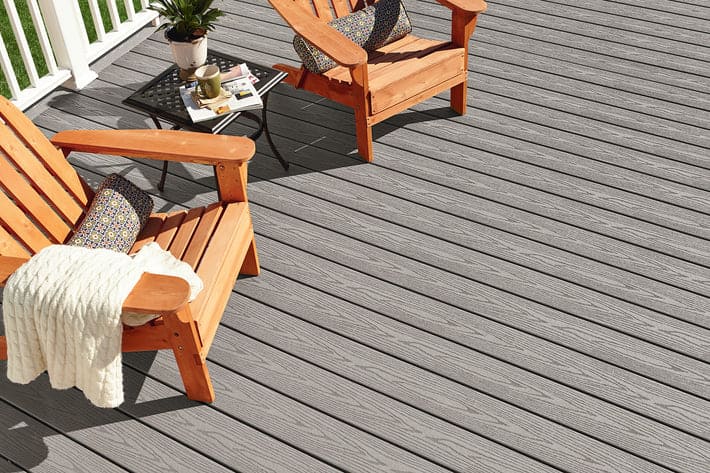Building a deck is an exciting and rewarding project that can significantly enhance the beauty and functionality of your outdoor living space. Whether you’re looking to create a cozy outdoor dining area or a sprawling entertainment space, a deck can be the perfect addition to your home. However, building a deck can also be a challenging project that requires careful planning, preparation, and execution. Read this step-by-step guide on how to build a deck!
That’s where our Capitol City Lumber comes in! Our experts in lumber and decking are happy to provide you with step-by-step instructions, tips, and tricks for your home DIY project to build a beautiful and sturdy deck that you can be proud of. If you’ve been considering building a deck for your home, but have been wondering how to build a deck that will last for years, we’ve got the answers.
Using Hardwood to Build a Deck
If you prefer a natural, timeless look for your deck, hardwood decking materials are a great option to consider. Hardwoods are known for their durability, strength, and resistance to weathering, making them a popular choice for outdoor projects.
Some of the most popular hardwood decking materials include treated lumber, cedar, Accoya, and ipe. While these materials are more expensive than softwoods, they require less maintenance and are less susceptible to rot and decay. Hardwood decks are also less likely to splinter, making them a safer option for families with children or pets.
When choosing hardwood decking materials, it’s important to select a reputable lumber supplier and ensure that the wood is sustainably sourced. With proper installation and maintenance, a hardwood deck can provide a beautiful and durable outdoor living space for many years to come.
Treated Lumber
Treated lumber is a popular option for building decks because it is treated with chemicals that make it resistant to rot, decay, and insects. Treated lumber is available in a variety of grades, with higher grades generally indicating a higher level of resistance to rot and decay. It is also available in different dimensions and can be cut to the desired size for your deck.
Accoya
Accoya is a type of modified wood that is becoming increasingly popular for use in decking projects. Accoya is made by treating sustainably-sourced softwood with a process called acetylation, which modifies the wood at a cellular level to make it more durable and resistant to rot and decay. Accoya wood is highly resistant to rot, decay, and insect damage, and can last for up to 50 years without needing to be treated or replaced. Additionally, Accoya is highly stable and resistant to warping, which helps it maintain its shape and structural integrity over time.
Cedar
Cedar is a popular choice for decking because of its natural beauty, durability, and resistance to decay and insect damage. Cedar contains natural oils and compounds that help to protect the wood from rot and decay, making it a good choice for outdoor applications where it will be exposed to moisture and humidity. Cedar decking is also known for its attractive color and grain patterns, which can range from light tan to reddish-brown. Over time, cedar decking will weather and develop a natural gray patina, giving it a rustic and weathered look.
Ipe
Ipe is a dense and durable hardwood that is prized for its strength, resistance to weathering, and natural beauty. One of the primary benefits of using Ipe for decking is its natural beauty. Ipe decking has a rich, deep brown color that can range from medium to dark, with unique and distinctive grain patterns. Over time, Ipe wood decking will weather to a silvery-gray color if left untreated, or it can be sealed to help maintain its natural color and beauty.
Using Composite and PVC Materials to Build a Deck
Composite and PVC decking materials are popular options for building a deck because they offer a number of advantages over traditional wood decking.
Composite decking is made from a blend of wood fibers and recycled plastic materials, which gives it the natural look and feel of wood while also providing increased durability and resistance to moisture, rot, and insects. On the other hand, PVC decking is made entirely from plastic materials and is highly resistant to staining, fading, and scratching.
Both composite and PVC decking requires minimal maintenance, as they do not require staining or sealing like wood decking does. Additionally, both materials are available in a wide range of colors and styles, making it easy to customize the look of your deck to your preferences. While composite and PVC decking can be more expensive than traditional wood decking, their long-lasting durability and low-maintenance requirements make them a worthwhile investment for many homeowners.
Step-by-Step Guide for How to Build a Deck
Building a deck yourself can be a manageable and enjoyable DIY project as long as you have the right materials and follow the proper steps for how to build a deck.
STEP #1: Deck Planning and Preparation
Deck planning and preparation involve several important steps that are essential for a successful deck-building project.
- Choose the deck location and size: Determine the location and size of the deck, taking into consideration factors such as the size of the yard, the layout of the house, and any existing structures or landscaping.
- Obtain deck permits: Obtain any necessary permits and check building codes to ensure that the deck is compliant with local regulations.
- Choose materials: It’s important to choose the materials and tools needed for the project, taking into consideration factors such as durability, maintenance requirements, cost, and aesthetics.
- Create a building plan: Creating a detailed plan for the deck can help ensure that the project runs smoothly and stays within budget. By taking the time to plan and prepare properly, you can help ensure that your deck-building project is a success.
STEP #2: Laying the Foundation for the Deck
The foundation of a deck is a critical component that provides stability and support for the entire structure.
- Mark deck perimeters: Clear the site and mark the perimeter of the deck, using stakes and string to ensure that the layout is square and level.
- Excavate the site: Excavate the site and level the ground, using a shovel, rake, and level to create a level surface for the foundation. The depth of the excavation will depend on the height of the deck, as well as local building codes and soil conditions.
- Install concrete footing: Install concrete footings or posts for the deck’s foundation. Footings should be installed below the frost line to prevent heaving, and posts should be installed plumb and level using a post level or laser level.
STEP #3: Build Deck Framing and Structural Support
Building the framing and structural support of a deck is an important step in creating a stable and safe outdoor living space.
- Build the deck frame: Build the frame of the deck using pressure-treated lumber, which is resistant to rot and decay. The frame should be constructed using a level and square layout, with beams running perpendicular to the joists.
- Install support beams and joists: Install the structural support beams and joists, using metal joist hangers to secure them in place. The spacing of the joists will depend on the size of the deck and the weight it will need to support, with closer spacing recommended for heavier loads. It’s important to use a level and square layout when installing the beams and joists to ensure that the deck is level and structurally sound.
- Secure the frame: The frame should be securely attached to the foundation or posts, using metal brackets or bolts to provide a strong and stable connection.
STEP #4: Decking and Railing Installation
Decking and railing installation is the next step when understanding how to build a deck, and involves installing the deck boards and any necessary railings and balusters.
- Install the deck boards: Using either screws or hidden fasteners to secure them in place, install the deck boards. Screws are a traditional and reliable option, while hidden fasteners offer a cleaner and more streamlined look.
- Cut and install railing posts and balusters: Cut and install any necessary railing posts and balusters, using metal brackets or connectors to secure them in place.
- Install railing and trim: The railings and trim pieces can be installed to finish off the look of the deck. Trim pieces can be used to cover any exposed edges or rough spots, while railings can be customized to match the style and color of the deck.
STEP #5: Finishing Touches for Your Deck
Finishing touches can take your deck from simply functional to a beautiful and inviting outdoor living space.
- Sand and finish the deck: One important step is to sand and finish the deck to ensure that it is smooth and free of splinters. This will not only make the deck more comfortable to walk on, but it will also help to prolong the life of the wood by preventing moisture from penetrating the surface.
- Apply protective coatings: Applying protective coatings, such as stain or sealant, can also help to protect the wood from the elements and prevent it from fading or discoloring over time. It’s important to choose a high-quality protective coating that is appropriate for your climate and the type of wood used for your deck.
- Add aesthetic and functional features: Additional features, such as lighting or built-in seating, can also enhance the functionality and appeal of your deck. Adding lighting can create a warm and inviting atmosphere for evening gatherings, while built-in seating can provide a comfortable and stylish seating option for you and your guests. Other features, such as planter boxes, pergolas, or outdoor kitchens, can also be added to customize the look and functionality of your deck.
STEP #6: Maintenance after Building a Deck
Regular maintenance is essential for keeping your deck looking beautiful and functioning properly after it’s been built. Let’s look at some of the ongoing maintenance tasks you can perform to ensure you get longevity out of your deck.
- Cleaning the deck: One of the most important maintenance tasks is regularly cleaning and inspecting the deck for any signs of damage or wear. This includes removing any dirt or debris from the deck surface and checking for any loose or damaged boards or fasteners.
- Repair deck damage: If any damage is found, it’s important to make any necessary repairs as soon as possible. This may include replacing damaged boards, tightening loose fasteners, or repairing any structural damage to the deck.
- Refinishing or resealing: Refinishing and resealing your deck will help to protect the wood from weather damage, such as fading, discoloration, or rot. The frequency of refinishing or resealing will depend on factors such as the type of wood, the climate, and the amount of foot traffic on the deck.
- Trim nearby vegetation: Regularly trim any vegetation near the deck, such as tree branches or shrubs, to prevent damage from falling debris or roots. Regularly sweeping or blowing leaves and debris from the deck surface can also help to prevent moisture buildup and protect the wood from decay.
Get the Best Wood for Building a Deck from Our Raleigh Lumber Supplier!
At Capitol City Lumber, our hardwood decking materials specialists pride ourselves on providing exceptional customer service and expert advice for all of your deck and lumber needs. Our knowledgeable staff can help you select the right materials for your project and provide tips and guidance on installation and maintenance.
Whether you’re building a small deck for a townhome or a large, multi-level deck for a spacious backyard, we have the materials and expertise to help you create a beautiful and functional outdoor living space.
Call us today at 919.832.6492 or get started by filling out our online contact form.



